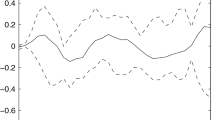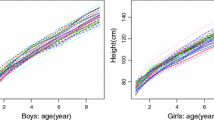Abstract
In the paper, we propose a functional dimension reduction method for functional predictors and a scalar response. In the past study, the most popular functional dimension reduction method is the functional sliced inverse regression (FSIR) and people usually use a fixed slicing scheme to implement the estimation of FSIR. However, in practical, there are two main questions for the fixed slicing scheme: how many slices should be chosen and how to divide all samples into different slices. To solve these problems, we first expand the functional predictor and functional regression parameters on the functional principal component basis or a given basis such as B-spline basis. Then the functional regression parameters will be estimated by using the adaptive slicing for FSIR approach. Simulation results and real data analysis are presented to show the merit of the new proposed method.
Similar content being viewed by others
References
AitSaïdi A, Ferraty F, Kassa R, Vieu P (2008) Cross-validated estimations in the single-functional index model. Statistics 42:475–494
Amato U, Antoniadis A, Feis ID (2006) Dimension reduction in functional regression with applications. Comput Stat Data Anal 50:2422–2446
Bongiorno EG, Salinelli E, Goia A, Vieu P (2014) Contributions in infinite-dimensional statistics and related topics. Società Editrice Esculapio, Bologna
Borggaard C, Thodberg HH (1992) Optimal minimal neural interpretation of spectra. Anal Chem 64:545–551
Cardot H, Ferraty F, Sarda P (2003) Spline estimators for the functional linear model. Stat Sin 13:571–591
Du J, Sun XQ, Cao RY, Zhang ZZ (2018) Statistical inference for partially linear additive spatial autoregressive models. Spatial Stat 25:52–67
Ferraty F, Vieu P (2006) Nonparametric functional data analysis: theory and practice. Springer, New York
Ferraty F, Mas A, Vieu P (2007) Nonparametric regression on functional data: inference and practical aspects. Aust N Z J Stat 49:267–286
Ferré L, Yao AF (2003) Functional sliced inverse regression analysis. Statistics 37:475–488
Ferré L, Yao AF (2005) Smoothed functional inverse regression. Stat Sin 15:665–683
Gramacy RB, Lee HKH (2008) Bayesian treed Gaussian process models with an application to computer modeling. J Am Stat Assoc 103:1119–1130
He G, Müller HG, Wang JL (2003) Functional canonical analysis for square integrable stochastic processes. J Multivar Anal 85:54–77
Horváth L, Kokoszka P (2012) Inference for functional data with applications. Springer, New York
Hu WJ, Guo JX, Wang GC, Zhang BX (2020) Weight fused functional sliced average variance estimation. Commun Stat-Simul Comput, pp 1–9
James G, Hastie T, Sugar C (2000) Principal component models for sparse functional data. Biomatrika 87:587–602
Li KC (1991) Sliced inverse regression for dimension reduction. J Am Stat Assoc 86:316–327
Li B, Zha HY, Chiaromonte F (2005) Contour regression: a general approach to dimension reduction. Ann Stat 33:1580–1616
Lian H, Li GR (2014) Series expansion for functional sufficient dimension reduction. J Multivar Anal 124:150–165
Liang BT, Gao TX, Bai DF, Wang GC (2021) Functional dimension reduction based on fuzzy partition and transformation. Aust N Z J Stat 64:45–66
Ramsay JO, Silverman BW (2002) Applied functional data analysis: methods and case studies. Springer, New York
Ramsay JO, Silverman BW (2005) Functional data analysis. Springer, New York
Wang T (2022) Dimension reduction via adaptive slicing. Stat Sin 32:499–516
Wang GC, Lian H (2020) Functional sliced inverse regression in a reproducing Kernel Hilbert space: a theoretical connection to functional linear regression. Stat Sin 30:17–33
Wang GC, Lin N, Zhang BX (2013) Functional contour regression. J Multivar Anal 11:1–13
Wang GC, Lin N, Zhang BX (2014) Functional k-means inverse regression. Comput Stat Data Anal 70:172–182
Wang GC, Zhou Y, Feng XN, Zhang BX (2015) The hybrid method of FSIR and FSAVE for functional effective dimension reduction. Comput Stat Data Anal 91:64–77
Wang GC, Feng XN, Chen M (2016) Functional partial linear single-index model. Scand J Stat 43:261–274
Wang GC, Zhou JJ, Wu WQ, Chen M (2017) Robust functional sliced inverse regression. Stat Pap 58:227–245
Wang GC, Zhang BX, Liao WH, Xie BJ (2020) Estimation of functional regression model via functional dimension reduction. J Comput Appl Math 379:1–19
Yao F, Müller HG (2010) Functional quadratic regression. Biomatrika 97:49–64
Yao F, Müller HG, Wang JL (2005) Functional data analysis for sparse longitudinal data. J Am Stat Assoc 100:577–590
Yao F, Lei E, Wu Y (2015) Effective dimension reduction for sparse functional data. Biomatrika 102:421–437
Yu P, Du J, Zhang Z (2017) Varying-coefficient partially functional linear quantile regression models. J Korean Stat Soc 46:462–475
Zhang JT, Chen J (2007) Statistical inferences for functional data. Ann Stat 35:1052–1079
Zhou J, Chen Z, Peng Q (2016) Polynomial spline estimation for partial functional linear regression models. Comput Stat 31:1107–1129
Zipunnikov V, Caffo B, Yousem DM, Davatzikos C, Schwartz BS, Crainiceanu C (2011) Multilevel functional principal component analysis for high-dimensional data. J Comput Gr Stat 20:852–873
Acknowledgements
The authors are very thankful to the Editor, Associate Editor, and a reviewer for their constructive comments and suggestions, which have helped significantly in improving the paper. Dr. Guochang Wang’s work is supported by the grants No. 20BTJ041 from the national social science fund of China.
Author information
Authors and Affiliations
Corresponding author
Additional information
Publisher's Note
Springer Nature remains neutral with regard to jurisdictional claims in published maps and institutional affiliations.
Appendix
Appendix
Proof of Theorem 3.1
According to the theorem, that is to say, as \(n \rightarrow \infty \),
where \(H_0=\{H_{01},H_{02},\ldots ,H_{0G}\}\) is the optimal scheme.
At first, we consider an over-slicing scheme \(H{'} \in \mathcal {H}_{+}\). For the sake of convenience, we assume that \(H{'}=\{H_{11},H_{12},H_{02},\ldots ,H_{0G}\}\), where \(H_{11}\) and \(H_{12}\) are two sub-slices formed from \(H_{01}\). That is to say, the slice \(H_{01}\) becomes two slices \(H_{11}\) and \(H_{12}\) in this case. We have
so
Therefore,
It is easy to show that
Therefore,
Since \(\bar{x}_{H_{1i}}=\bar{x}_{H_{01}}+O_p(n^{-\frac{1}{2}}),i=1,2\), we can obtain
In general, this result will hold for any \(H{'} \in \mathcal {H}_{+}\), i.e, as \(n \rightarrow \infty \),
Then consider the case that \(H{'}\) is under-slicing scheme, that is to say \(H{'} \in \mathcal {H}_{-}\). For simplicity, we can assume that \(H{'}=\{H_{00},H_{03},\ldots ,H_{0G}\}\), where \(H_{00}\) is a new slice constructed by merging two slices \(H_{01}\) and \(H_{02}\). We have
Therefore,
Meanwhile, it is easy to show that
Therefore,
Since \(\tilde{B} \tilde{B}^\intercal =B_0 B_0 ^\intercal +O_p(n^{-\frac{1}{2}})\), we can obtain
That is to say, there exists a constant \(c<0\) so that \(BIC(H{'},\tilde{B})-BIC(H_0,\tilde{B})<c\), with probability tending to 1 as \(n \rightarrow \infty \). In general, this result will hold for any \(H{'} \in \mathcal {H}_{-}\), i.e, as \(n \rightarrow \infty \),
Combining these two cases, we can obtain
the proof is complete. \(\square \)
Rights and permissions
Springer Nature or its licensor (e.g. a society or other partner) holds exclusive rights to this article under a publishing agreement with the author(s) or other rightsholder(s); author self-archiving of the accepted manuscript version of this article is solely governed by the terms of such publishing agreement and applicable law.
About this article
Cite this article
Zheng, L., Liang, B. & Wang, G. Adaptive slicing for functional slice inverse regression. Stat Papers (2024). https://doi.org/10.1007/s00362-023-01518-w
Received:
Revised:
Published:
DOI: https://doi.org/10.1007/s00362-023-01518-w




